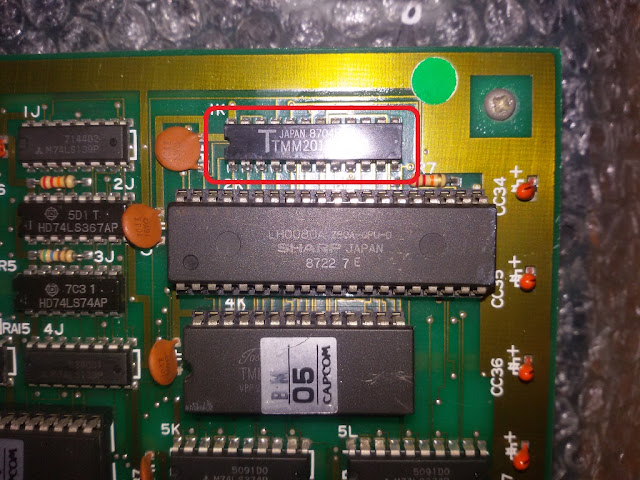Received for repair a V-Five PCB, a vertical shooter arcade video game originally developed and published by Toaplan and also know as 'V-V / Grind Stormer'.The board was in very good condition :
But it booted all the time to a 'PALLET RAM ERROR' message on screen (I think 'pallet' is a japanese misspelling of 'palette')The palette RAMs are two 2K x 8-bit devices @U4-U5 (Sharp LH5116 the exact part used)
Probing them with a logic probe revealed some stuck outputs of the device @U5 :
I promptly pulled the chip and tested it out circuit.It failed :
With a good RAM chip fitted the board finally booted into game:
I wanted to play some games for testing further the board but I could not coin up with player 1.Pin 16 parts side of JAMMA connector was stuck low :
I traced the input back to a custom resistor/capacitor array marked 'RC8528' :
Measuring the resistance of the internal resistors (which act as pull-up) I found one with a value lower (588 Ohm) than others (4.7K Ohm)
The part was bad internally but I had no spares of it.I remembered some years ago I reproduced a similar custom resistor/capacitor array used on NMK PCBs (marked as 'NMK-006') so, after figured out the correct resistors values, I assembled one and installed it :
But I was still unable to coin up.Still going backwards there is a 74LS240 @U29, input pin 8 was almost shorted to GROUND :
Pulled the device and tested it out-of-circuit, it failed in the exact logic gate unit :
Fitted a good chip and I was finally able to coin up.All seemed working fine but going futher into the game I noticed some sprites were glitched :
All the graphics are generated by the custom ASIC ' GP9001' which produces the addresses for six Fujitsu MB81C4256 (256K x 4-bit) dynamic RAMs and read back their data :
I found the datasheet of this DRAM and looked at pinout :
The device failed when tested out-of-circuit:
A fresh RAM chip was installed on machine tooled socket to finish the job :
Board 100% fixed and another successful repair.



































